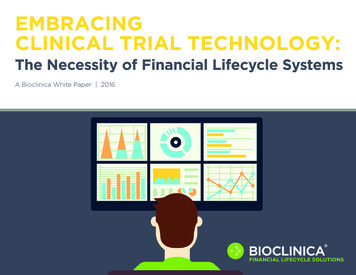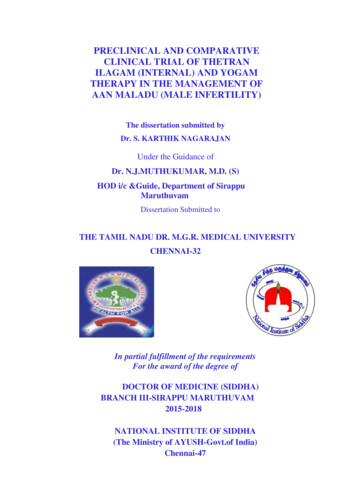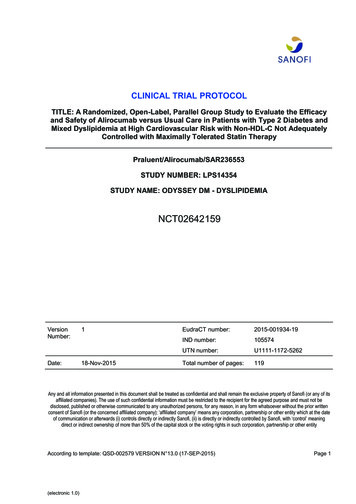
Transcription
EMBRACINGCLINICAL TRIAL TECHNOLOGY:The Necessity of Financial Lifecycle SystemsA Bioclinica White Paper 2016
IVRS also gave clinical trial sponsors the first real-time window into thestatus of clinical trial enrollment.IntroductionThe automation of clinical trials has been an ongoing evolution, and onethat benefits the collection of trial and study management data.Over the past decade, the industry has eliminated many manual processes,such as the handling of paper case report forms and the time-consumingprocess of double data entry with electronic data capture. In fact, an industryreport suggests the clinical trial technology sector could top 5 billion by2018, especially as globalization, outsourcing of clinical trial processes andtrial complexity continue to increase.1 With each advance in technology,clinical trial sponsors and contract research organizations enjoy ever-finerdegrees of transparency over all aspects of study execution.However, even with all of these improvements, there are still majorpockets of manual processes within clinical development that need to beautomated.The next logical evolution for automating the management of clinical trialdata took shape in the emergence of clinical trial management systems(CTMS) in the 1980s and 90s. CTMS represented a major advancement inthe oversight of clinical trials as they brought automation to hundreds ofstudy document management elements that used to be tracked using arange of paper files and spreadsheets.By using CTMS, trial sponsors could better manage a wide range of studydocuments and data points, including regulatory document tracking andmanagement, study timeline tracking, site and subject tracking, study statustracking, study resource management and reporting.And CTMS became even more powerful when the capability to link sets ofstudies together was introduced, allowing for a program-level view of studyprogress.HistoryA Timeline of Technology in theTechnology has been a great boon to the clinical trial industry and still hasa richer role to play.In the 1960s when companies became large enough to afford (then)cutting-edge technologies including mainframes and mini-computers, itfirst became possible to count and track the many reams of data collectedduring a clinical trial within a database.Widespread adop on of Interac ve Voice ResponseWidespread adop on of Interac ve Voice ResponseSystems (IVRS)Systems (IVRS)Emergenceof clinicaltrial managementEmergenceof clinicaltrial managementsystems(CTMS)systems (CTMS)Introduc onof ElectronicIntroduc onof ElectronicData DataCapture(EDC) (EDC)CaptureWidespreadadop onof EDC of EDCWidespreadadop onIntroduc onofIntroduc onofcloud-based servicescloud-based services2010s2010s2000s2000s1990s1990s Embracing Clinical Trial Technology: The Necessity of Financial Lifecycle Systems1980s1980s1970s1970sIn the 1970s and 80s, the clinical trial technology revolution continuedwith widespread adoption of Interactive Voice Response Systems (IVRS),layering new functionality over old technology—specifically enhancing thepower of the telephone already located at every clinical trial site. Throughcomplementing telephones, IVRS were able to assist clinical trial sponsorsin enrolling and randomizing clinical trial subjects as well as managing sitesupplies.A Timelineof Technologyin theClinicalTrial IndustryClinical Trial Industry1
In addition, the Internet’s growing availability in the 1990s proved to betransformational for clinical trial technology. While databases had beenaround since the 1960s, sites still recorded clinical data on no carbonrequired (NCR) forms, which were manually collected and shipped to acentral site. Once they arrived, information was taken off of the NCRs byhand and then entered into a corporate database — a manual process thatproved both time-intensive and expensive.Electronic data capture (EDC) soon emerged as the next clear iterationin clinical trial financial software. It allowed sites to enter data into aproprietary system over the Internet. Monitoring was still required, butEDC eliminated lag-time in the availability of real-time data and opened upmore possibilities for real-time decision-making and adaptive approachesto trial execution.Bridging a Big Technology GapHowever, despite significant advances, there are still significant areas withinclinical development that would benefit from automation and technologysolutions. The manual efforts behind cobbled-together processes are notonly error-prone, but also require an enormous amount of time. This isparticularly evident in Phase III clinical trials, which saw a 70% increase inlength from 1999 to 2005.2 In addition, the BioPharma industry has seen anoverall lengthening of total clinical development, which is an estimated 6.8years, up from 6 years in the 1999 to 2001 timeframe, a 13% increase.3 Initialefforts to reduce cost have focused on protocol design and changes inmonitoring activities. While accepted in principle, the introductionof technology to lower cost, improve delivery and reduce time is moredifficult to measure in terms of ROI.Ultimately, EDC made the collection of data easier and less expensive,so sponsors could better comply with increasing Food and DrugAdministration requirements calling for information. S tudy supply management and tracking systems. These support thecomplex process of manufacturing specialty study supplies, labelingthem correctly and handling the logistics for shipments andeventually collecting from sites as necessary.6.8 yearsNumber of YearsNow Sponsors can now leverage the use of cloud-based technologies toalign themselves of a wide range of information systems that have variousroles in automating clinical development. These current technologies makethe process of conducting clinical trials more efficient, and include:The Length of Clinical DevelopmentSince 199913%increase E lectronic trial master file management systems. These documentmanagement solutions ensure that the thousands of studydocuments are electronically filed and controlled. P rotocol automation technology. These support the creation, reviewand approval of protocols.6 years2000 Embracing Clinical Trial Technology: The Necessity of Financial Lifecycle Systems2005201020152
However, as clinical trials extend their global reach and increase in complexity, many believe the industry has reached a tipping point and mustnow embrace technology in order to streamline clinical trial activity.But in order to have a true end-to-end solution, it would need to marryautomation of data evaluation with the data source of truth and use theevaluation outputs to transition through the lifecycle of a trial or program.One major gap in this transition is in financial visibility. Many processes aresiloed and manual, making them inefficient in providing visibility into trialperformance. As a result, there is limited financial visibility for sponsors,CROs and sites. Operational performance is often discussed as the key to asuccessful trial, but all of that is linked to the contractual and financial costof execution. Sites want accurate and timely payments for the operationalwork performed; sponsors want to know what the expense picture of theirtrial looks like; and CROs want to be able to give their clients real-time options to affect trial outcomes rather than trying to minimize the impact ofsomething that is already done.and track contracts in a document management system, and then useCTMS to track some site payment information. Meanwhile, actual trial sitepayments are executed and accruals are tracked through separate spreadsheets or an ERP system that is not integrated with operational systemsand/or data. And when automated pieces of the financial system don’tcommunicate, spreadsheets — with all of their flaws — become the defaultintermediary between them.The solution?A truly complete financial lifecycle system.This is evident by the number of financial processes still relying onspreadsheets. Spreadsheets should be a last resort as they present anumber of problems for trial sponsors because they require manualmaintenance, uniformity, and consistent controls. They are also proneto accidental transcription errors and other inaccuracies.BIOCLINICAFinancialLifecycle SystemEven today, the financial lifecycle of clinical trials (budgeting and forecasting, contract management, site payment generation, site/subject paymentmanagement, accounting, accruals, and reporting) is still greatly dependenton spreadsheets. Proving this point, 70% percent of companies reportedin a recent Bioclinica study that their primary tool used for budgeting andforecasting is Microsoft Excel.While some companies have automated individual pieces of their financiallifecycle, these disparate systems are rarely capable of talking to eachother. For example, a company might track budgets in a financial system Embracing Clinical Trial Technology: The Necessity of Financial Lifecycle Systems3
An Overview:The Financial Lifecycle SystemA financial lifecycle system (FLS) is a new type of software that handles theglobal financial aspects of a clinical trial: T he process begins by automating the budget consolidation andperforming ‘what if scenario simulations.’ T he budget then becomes the basis for contract negotiation whereeach contract term, whether listed in an SOW or a term listed in thesite study budget in the Clinical Trial Agreement (CTA), is agreed toand becomes the basis for financial transactions. T he finalized contract terms are analyzed against the sourceoperational and EDC data (record of truth), and upon a term beingfulfilled, a financial transaction is generated. F inancial transactions are managed with internal routing andapproval, and ultimately, payment is made to the vendor. T ransactions are aggregated for GAAP (general accepted accountingprinciples) accounting and transparency reporting, providing yourpartner with the ability to view the financial status of their payments. A ctual data is then analyzed by the forecasting and planning engineand used to perform re-planning simulations.One of the great values of an FLS becomes clear when site payments areconsidered. By some estimates, sites are paid more than 90 days after theyhave completed the contractual work that qualifies them for payment; andthis is an understandable frustration for sites that have to pay their ownbills in 30 days.In order to automate investigator payments, an FLS payment system determines when a site has qualified for a payment and how much money is dueunder the contract terms. But to accomplish that, a site’s contract detailsmust be coded into language that a software solution can understand.From that point, the FLS applies the contract language against the actualdata found in other systems, including EDC, IVRS, CTMS and any othereClinical system. Going to the source of truth removes the need to bouncedata from one system to another, a timely process that opens the door formanual error, and also provides a unique view into site performance. It’salso important that the system understands and tracks unique aspects ofsite contract including holdbacks, caps, and invoiceables.Once a site’s trial payment has been triggered and quantified, an FLSsupports a range of disbursement processes based on the necessary rolesand authorizations required for the size and amount of payment. To enablefull automation, the FLS is able to interface with financial networks to allowfor seamless automation of electronic payments. By linking the financialdata to the operational performance or activity, one can illustrate a truefinancial picture of the trial.An FLS also includes a generally accepted accounting principles (GAAP)accounting system tying in to the corporate general ledger system. TheFLS accommodates industry regulations, such as the Physician PaymentSunshine Act, while also working with other systems to combine paymentdata into a seamless whole.Budget management and forecasting is another area where an FLSprovides immense value. In the typical process for forecasting expenseand study duration, the site feasibility survey that is used for site selectionbecomes the primary tool to estimate enrollment per site, and enrollmentis forecasted on a straight-line bases. However, our analysis shows thatmore than 80% of clinical trial costs are associated with the timing of sitereadiness (this is the date sites can begin enrolling subjects) and subjectenrollment. Embracing Clinical Trial Technology: The Necessity of Financial Lifecycle Systems4
With an FLS, users can define any milestone date, which can be referencedby any user-defined activity or task, to automatically reforecast the futureexpense date as key user-definable dates are updated. This enablesfinancial managers to calculate expense and cash forecasts as well as timingby changing linked key dates. Dynamic amounts change based on linkedassumptions change, such as the number of monitoring visits. Further, thesystem can generate an expense and cash forecast and designate a primarybudget to compare and report against actual results.And like other modern systems, an FLS supports robust reporting that willdrill down into financial details.ConclusionReferencesTaylor N. P. The clinical trial technology sector could top 5Bby 2018, report says. January 26, 2014. Accessible at: l-technology-sector-tippedtop-5b-2018/2014-01-26.2 Gaffney A. Report: Phase III Clinical Trials Behind Increase in the Costof Pharmaceuticals. April 25, 2013. Accessible at: px sthash.XUuVoQPm.dpuf3 Morrison R. Technology’s Role in Clinical Trials. March 5, 2015.Accessible at: ogys-role-clinical-trials - edn4.1 Over the last couple of decades, the clinical development industry hasleveraged technology to conduct trials faster and more affordably withgreater efficiency. But there is still a need for widespread adoption ofautomation and technology when it comes to the financial aspects ofclinical trials.Much of the financial side of clinical trial operations remains heavilydependent on the manual development and maintenance of error-pronespreadsheets. It’s time to recognize how a robust and flexible FLS can eliminate errors and increase efficiency by automating the last vestigesof manual processing.Ready to say no to more spreadsheets? Contact us to learn how theBioclinica FLS can automate and accelerate your clinical trial paymentsprocess.info@bioclinica.com888-275-2462 Embracing Clinical Trial Technology: The Necessity of Financial Lifecycle Systems5
IVRS also gave clinical trial sponsors the first real-time window into the status of clinical trial enrollment. The next logical evolution for automating the management of clinical trial data took shape in the emergence of clinical trial management systems (CTMS) in t











